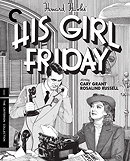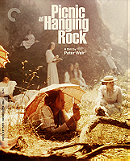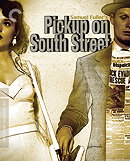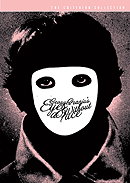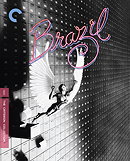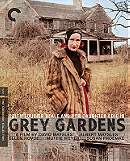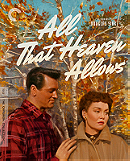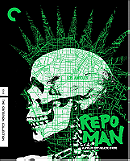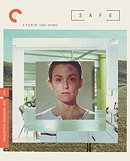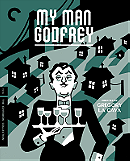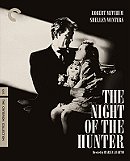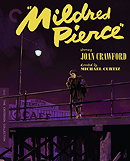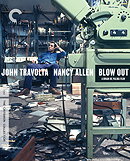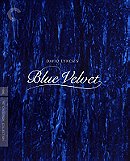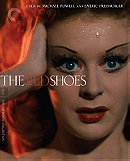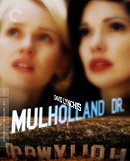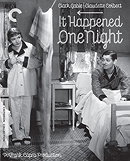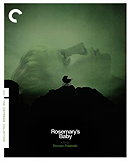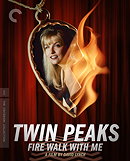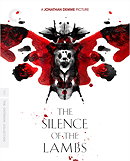My Criterion
Sort by:
Showing 24 items
Rating:
List Type:
His Girl Friday
Rapid-fire, overlapping dialogue, general zaniness, and improvisation abound any comical Cary Grant vehicle from the pre-war Hollywood era, however, none have proved as venerated as "His Girl Friday". Eight decades on, Howard Hawks' fresh, finessed, fast-talking newsroom rom-com remains the definitive screwball comedy. Despite its whirlwind pace, meta ad-libs and criticism of domesticity, it is the forward-thinking sexual politics of the film, i.e. switching the gender of the original story, thus adding a remarriage plot and interaction of the male-dominated newsroom into the mix, that fortify its timeless quality. Hildy Johnson is one of cinema's powerful women, returning to the madness of press reporting instead of becoming a housewife, a role deemed more acceptable; paired with Cary Grant's charismatic, conniving editor Walter Burns, they are an aggressive force exchanging quips, barbs and interruptions smack dab in the middle of a convoluted impending execution plot. Hildy is not a "Friday", nor does she truly want to be "treated like a woman" - covering the case promised as a condition for a life insurance policy courtesy of her new beau causes her to realise where she belongs, and it is not as a dutiful wife in the suburbs.
Along with his typical use of motifs and commonalities, Hawks again celebrates the natures, conflicts, spontaneity, obstinacy and amorality of his characters, forcing the audience to root for a couple who are difficult and infallible rather than romantic or star-crossed. It is Hildy's desire to be viewed not as a woman but as a professional that eventually draws her back to Walter, who acknowledges how brilliant she is in that capacity and refuses to give her up, thus setting in motion a absurd series of events culminating in their remarriage, even if they are fated to prioritise their respective careers over domestic bliss. In spite of her visible disdain for and awareness of his manipulative nature, as well as their lack of affection for each other, the balance of power in Hildy and Walter's marriage is far more interesting to watch; Hildy is Walter's equal, and Hawks demonstrates as much through specific camerawork, namely by refusing to shoot Rosalind Russell differently to Cary Grant. With both actors receiving commensurate screen time, one-liners and repartee synchronically and as part of an ensemble, it is this constant display of argument, concord and snappy interplay spearheading the film's sparkling situations and chemistry, and amongst the sparring and scheming to usurp and overthrow each other for a story, pardon, term of office, or ace employee/wife, it becomes clear that in Hawks' (and Walter's) unscrupulous world, intelligence and capability are far more advantageous than love, gender or status.
Along with his typical use of motifs and commonalities, Hawks again celebrates the natures, conflicts, spontaneity, obstinacy and amorality of his characters, forcing the audience to root for a couple who are difficult and infallible rather than romantic or star-crossed. It is Hildy's desire to be viewed not as a woman but as a professional that eventually draws her back to Walter, who acknowledges how brilliant she is in that capacity and refuses to give her up, thus setting in motion a absurd series of events culminating in their remarriage, even if they are fated to prioritise their respective careers over domestic bliss. In spite of her visible disdain for and awareness of his manipulative nature, as well as their lack of affection for each other, the balance of power in Hildy and Walter's marriage is far more interesting to watch; Hildy is Walter's equal, and Hawks demonstrates as much through specific camerawork, namely by refusing to shoot Rosalind Russell differently to Cary Grant. With both actors receiving commensurate screen time, one-liners and repartee synchronically and as part of an ensemble, it is this constant display of argument, concord and snappy interplay spearheading the film's sparkling situations and chemistry, and amongst the sparring and scheming to usurp and overthrow each other for a story, pardon, term of office, or ace employee/wife, it becomes clear that in Hawks' (and Walter's) unscrupulous world, intelligence and capability are far more advantageous than love, gender or status.
Picnic at Hanging Rock
Experiencing Peter Weir's simmering "Picnic at Hanging Rock" is akin to a lucid dream so incredibly vivid and knowable in a subconscious state of mind though inscrutable outside of it. Piercingly poignant, sharply drawn and entirely plausible, the characters and the deeply troubling situation that occurs upon their encroaching on a phenomenal territory is depicted as indirectly malevolent and inherently ambiguous. Owing to the mellow, eulogistic approach to plot and pacing, credibility may be stretched for those unfamiliar with the Australian New Wave movement. It is the striking, mesmeric quality of the cinematography, breathtaking surroundings and reflective mood suffusing Peter Weir's sixth feature that render it immeasurably greater in stature and sophistication than his less panoramic earlier work. Marked by a sense of insubstantiality, the surreal, illusory attributes and gauzy, hallucinatory appearance of this masterpiece are to name but a few of its distinguishing features.
Based on a celebrated novel taking place on St Valentine's Day in the year 1900, the story concerns the devastating impact on a local community when three students and a young French teacher of Appleyard College inexplicably vanish whilst exploring the titular geological formation. From the diffused, impressionistic aesthetic, mystery narrative devoid of solution and the vague, enigmatic tonality, the film is as unsettling and disturbing as any conventional horror. In "Picnic at Hanging Rock", such mundane, seemingly insignificant incidents as falling asleep due to the warmth of the midday sun or clocks stopping at noon are as worrisome and jarring as the overwhelming absence felt in the aftermath of the disappearance. Conversely haunting and romantic, it is within the hallmarks of Australia's hypnotic yet unforgiving open landscape whereby the lush, evocative details are revealed, enhancing the film's cryptic, unfathomable nature. Decoding and unravelling undertones and meanings is fruitless; themes of sexual repression, morality and spiritualism may provide theories, but that is all they are. Theories. "Picnic at Hanging Rock" depends on a subjective perspective in order to truly appreciate it as an instinctive journey without a definitive destination requiring personal interpretation of its nuances and allusions, and therein lies its exceptionalism. Drawing your own conclusions and allowing the atmosphere of the film to invade your senses, most notably its blistering scenery and natural environment, contrasts, motifs and symbols, is the key to fully immersing yourself into its Gothic consciousness. Indecipherable and lyrical, replete with unseen presences, as well as the untamed rock frozen in time colliding with civilisation, the Australian Bush at the core of the puzzle is a beautiful, impenetrable monster capable of exercising its power long after the fateful expedition of the site. An ethereal, artistic standout in the emergence of creative vitality for Australian cinema in the 1970s that defies logic, having recourse to rely on incongruity, tantalisation and eerie sensuality to achieve an unparalleled form of cinematic seduction permeated by oblique poetics.
Based on a celebrated novel taking place on St Valentine's Day in the year 1900, the story concerns the devastating impact on a local community when three students and a young French teacher of Appleyard College inexplicably vanish whilst exploring the titular geological formation. From the diffused, impressionistic aesthetic, mystery narrative devoid of solution and the vague, enigmatic tonality, the film is as unsettling and disturbing as any conventional horror. In "Picnic at Hanging Rock", such mundane, seemingly insignificant incidents as falling asleep due to the warmth of the midday sun or clocks stopping at noon are as worrisome and jarring as the overwhelming absence felt in the aftermath of the disappearance. Conversely haunting and romantic, it is within the hallmarks of Australia's hypnotic yet unforgiving open landscape whereby the lush, evocative details are revealed, enhancing the film's cryptic, unfathomable nature. Decoding and unravelling undertones and meanings is fruitless; themes of sexual repression, morality and spiritualism may provide theories, but that is all they are. Theories. "Picnic at Hanging Rock" depends on a subjective perspective in order to truly appreciate it as an instinctive journey without a definitive destination requiring personal interpretation of its nuances and allusions, and therein lies its exceptionalism. Drawing your own conclusions and allowing the atmosphere of the film to invade your senses, most notably its blistering scenery and natural environment, contrasts, motifs and symbols, is the key to fully immersing yourself into its Gothic consciousness. Indecipherable and lyrical, replete with unseen presences, as well as the untamed rock frozen in time colliding with civilisation, the Australian Bush at the core of the puzzle is a beautiful, impenetrable monster capable of exercising its power long after the fateful expedition of the site. An ethereal, artistic standout in the emergence of creative vitality for Australian cinema in the 1970s that defies logic, having recourse to rely on incongruity, tantalisation and eerie sensuality to achieve an unparalleled form of cinematic seduction permeated by oblique poetics.
Pickup on South Street
In decidedly hard-boiled, cynical fashion, "Pickup on South Street" vies communism and greed against patriotism and passion, and with such opposing forces at play, the true objective of juxtaposing the Feds and the Commies as being equally manipulative and unscrupulous was bound to be misconstrued. Samuel Fuller's aim was to present the so-called ruthless criminals operating within the framework of capitalism and living on the fringes of American society - one lives in a basement, the other in a seaside shack - inextricably tethered, and prepared to die, for a country that failed them. Redemption for any transgressions committed occurs in the form of a tenuous connection forged in double-crossing and blackmail, fraught scenes capturing the fine line between violence and sex. Amid the captivating close-ups and pellucid visuals, Fuller's venture into the dark arena of noir is not without its subtleties; the repartee, subtext-laden dialogue is so pure, authentic and rich that it rewards repeat viewings. Devoid of a savage, surly femme fatale - our female heroine, played to perfection by Jean Peters, is so likeable, naive and unwitting that she wholly defies the term - and her gullible target, who in Fuller's world is the cocky, sneering representative of America's stoic, post-war American male ideal, "Pickup on South Street" nevertheless exemplifies the dim-lit haze, bleakness and sleaze of the genre. Stimulating and thrilling as you would expect for an 80-minute film directed by a director as passionate and distinctive as Fuller, the concise and cogent story ties together perfectly, fortunately lacking the downbeat ending employed by his contemporaries. Opting against progressively toughening his characters, he moderates and humanises the more appealing players, accurately depicting their labile attitudes, allegiances and motivations, thus ensuring that they are more potent, well-drawn and convincing to watch as a result.
Eyes Without A Face
Lurid, spine-tingling and yet strangely magical, the gruesome and ghastly acts of a disturbed plastic surgeon determined to restore the beauty of his disfigured daughter recall Lugosi and Poe, but aided by the distinguished direction of Georges Franju, the somewhat pulpy aspects of the plot are given a weirdly poetic slant. Initially causing controversy due to its convincing surgical scenes, "Eyes Without A Face" is now relatively tame by modern standards, and perhaps more revered as a result. Certain intrusive graphic details of the film, such as the secluded French countryside setting and minimal yet persuasive gore, are deftly complemented by a jaunty carnival musical theme. Franju utilises off-kilter imagery and Cocteau-esque story elements to create an imposing atmosphere by placing emphasis on slivers of despair and sadness, not to mention the collateral and destructive psychopathy of its characters.
Edith Scob's unforgettable masked visage is now recognised as an iconic image of horror cinema, and though veering into cult-like fascination, it is best revered in context, since the film is far too layered to be encapsulated by a single visual, no matter how striking. "Eyes Without A Face" is sophisticated, penetrating and haunting - not words often associated with the horror genre, but this moody, poisonous marvel is one step above most of its expressionist predecessors in that it requires more understanding to experience its inherent lyricism.
Edith Scob's unforgettable masked visage is now recognised as an iconic image of horror cinema, and though veering into cult-like fascination, it is best revered in context, since the film is far too layered to be encapsulated by a single visual, no matter how striking. "Eyes Without A Face" is sophisticated, penetrating and haunting - not words often associated with the horror genre, but this moody, poisonous marvel is one step above most of its expressionist predecessors in that it requires more understanding to experience its inherent lyricism.
Brazil
In Terry Gilliam's dystopian magnum opus, a typographic error sets in motion a series of events involving a daydreaming government employee tasked with rectifying said mistake. "Brazil" is broadly satirical, tonally solemn, and by the same token underscored with an abundance of dark humour, reverie and idiosyncrasies. It is within this bleak future that ultimately draws inspiration from Chaplin's "Modern Times" by way of steampunk subculture, championing the everyman's struggle in a cruel, unforgiving autocratic world ruled by overelaborate machinery. Retro-futuristic and hyper-bureaucratic in design and atmospherically oppressive, the 20th century political landscape conveys the impression of authoritarianism, delineated by anachronistic technological imagery, German expressionism, plastic surgery and Big Brother-esque surveillance. Gilliam's singular vision refers to the past more so than the present or future, and is neither European or American in its settings, perhaps a combination of the two continents in terms of economics, politics and infrastructure. Upon its initial release, the microcosm anticipated by Gillian was a long way from materialising but is now viewed as a surprisingly accurate depiction of conversely controlled and chaotic 21st century life.
Ostensibly, "Brazil" is the culmination of Gilliam's strange and distinctive world view, a nightmarish composite of many creative influences, from Orwell, Kafka, and Fellini. It remains utterly prophetic, hilarious, soul-crushing and chilling piece of farcical, imaginative cinema you must revisit to truly decipher its fantastical genius.
Ostensibly, "Brazil" is the culmination of Gilliam's strange and distinctive world view, a nightmarish composite of many creative influences, from Orwell, Kafka, and Fellini. It remains utterly prophetic, hilarious, soul-crushing and chilling piece of farcical, imaginative cinema you must revisit to truly decipher its fantastical genius.
Grey Gardens
A lesson for any budding filmmaker in how to observe objectively, honourably and plainly, "Grey Gardens", is one of those frequently referred must-see documentaries that, depending on your viewpoint, can be read in different ways. Albert and David Maysles are permitted access to the fairly dilapidated hidden fortress of two hugely fascinating characters, Little Edie and Big Edie, both of whom unintentionally demand attention and cult-like reverence from the moment they address the filmmakers with that extraordinary manner of speech. The two Edies invite the cameras into their formerly active mansion in exactly the same way that a modern celeb or real estate agent would, but as the Edies' lachrymose reminiscences and passive-aggressive squabbling assume a subsidiary role to the admittedly arresting surroundings, it is left up to the audience to decide what to make of it all. Albert and David Maysle, despite their best efforts, cannot avoid turning the audience into reluctant spectators to tragedy, decay and disorder, but when the content is as historically important and downright absorbing as this, how can one possibly allow their principles to take priority over artistic edification? After all, without the film and its ensuing significance, the Edies would not have been able to sell the property, which has now been restored.
All That Heaven Allows
Douglas Sirk achieved his greatest success as a filmmaker, both commercial and critical, in the 1950s, during which time his work reflected the social and domestic issues of women. Utilising mise en scène, colours, lighting, camera angles, and composition whilst addressing banalities and seemingly
insignificant subjects. Critics overlooked the profundity and sophistication at the core of Sirk's vision, which was free from ambiguity and verisimilitude yet entirely scathing in its veiled attack on American society and its hidden traps.
Sirk's films are contemporaneously viewed as being latent with criticism, indirectness and undertones that only enhance its timeless qualities, thus deeming it worthy of reappraisal and analysis. "All That Heaven Allows" embodies the distinctive Sirkian style, exhibiting a vapid superficiality that shrouds its symbolism. Sirk's submission to his expressionistic leanings culminated in him creating what ultimately be considered one of the greatest films of all-time. Vivid, evocative and teeming with messages yearning to be deciphered by the infinitely more discerning viewer, "All That Heaven Allows" veers towards the artistic side of Sirk's repertoire in spite of its accessible surface pleasures, namely an utterly pulchritudinous Rock Hudson.
Invariably, Sirk's "women's weepie" pictures prior to 1955 were more akin to his theatre work, but subsequent to that, he blossomed in terms of his technique and execution. "All That Heaven Allows" is the apex of Sirk's maturity as a filmmaker; components and elements of the his trademark methods such as light and shade, vibrant Technicolor cinematography, the use of mirrors, and an engrossing May-September romance storyline, were established in his previous film "Magnificent Obsession", but the formula was repeated, finalised, polished and enriched herein. From its nuanced, stunning aesthetic and subversive social perspective, this is an emblematic, beautifully composed encapsulation of Sirk's immense talent.
insignificant subjects. Critics overlooked the profundity and sophistication at the core of Sirk's vision, which was free from ambiguity and verisimilitude yet entirely scathing in its veiled attack on American society and its hidden traps.
Sirk's films are contemporaneously viewed as being latent with criticism, indirectness and undertones that only enhance its timeless qualities, thus deeming it worthy of reappraisal and analysis. "All That Heaven Allows" embodies the distinctive Sirkian style, exhibiting a vapid superficiality that shrouds its symbolism. Sirk's submission to his expressionistic leanings culminated in him creating what ultimately be considered one of the greatest films of all-time. Vivid, evocative and teeming with messages yearning to be deciphered by the infinitely more discerning viewer, "All That Heaven Allows" veers towards the artistic side of Sirk's repertoire in spite of its accessible surface pleasures, namely an utterly pulchritudinous Rock Hudson.
Invariably, Sirk's "women's weepie" pictures prior to 1955 were more akin to his theatre work, but subsequent to that, he blossomed in terms of his technique and execution. "All That Heaven Allows" is the apex of Sirk's maturity as a filmmaker; components and elements of the his trademark methods such as light and shade, vibrant Technicolor cinematography, the use of mirrors, and an engrossing May-September romance storyline, were established in his previous film "Magnificent Obsession", but the formula was repeated, finalised, polished and enriched herein. From its nuanced, stunning aesthetic and subversive social perspective, this is an emblematic, beautifully composed encapsulation of Sirk's immense talent.
Repo Man
Conjuring an aesthetic of backstreet video stores, flaming boots and Black Flag cassette tapes, "Repo Man" permeates counterculture haziness, carnage and anarchy. Never quite snugly fitting the categories it often straddles, namely comedy and science fiction, "Repo Man" revels in its indistinguishable tone, weaving threads of familiarity and off-kilter surrealism throughout in order to leave you discombobulated as possible. Despite blurring a multitude of elements, themes, philosophies, and styles, "Repo Man" is linear in the loosest sense of the word, with its unfurling plot revolving around a dissatisfied, unfocused LA nihilist inadvertently entering the murky, highly dangerous world of auto repossession, which in turn sees him stumble across a goofy conspiracy. With its impeccable oddness and attention to detail, the film is brimming with extras and facets, harnessing the unbridled energy of hardcore punk and reproducing the moral and infrastructural decay of a downtrodden American society to capture a fleeting moment in time when movies without mainstream leanings could still find an audience.
Safe
Inherently creepy, ominous and unsettling to such a degree that the villain of the piece becomes the film's atmosphere itself, "Safe" is decidedly eerie to say the very least, never reaching boiling point despite simmering close to it innumerably during its runtime. Safe havens and certainty of any description is the aim of the film's invisible protagonist Carol White, and as she searches for meaning and self-worth in the unforgiving 20th century. She discovers an identity through the sudden onset of a series of acute but physically inexplicable symptoms, manifested as allergic reactions to the most banal and seemingly innocuous elements, from perm solution to exhaust fumes. Even minimal exposure triggers an attack, and so she quickly finds herself at odds with the world around her, not only to the dangers lurking in her environment, also to her pachydermatous doctors as well as well-meaning but entirely hollow friends and family.
Whatever ails our heroine is never explicitly accepted until she finds solace in a cult-like New Age self-help retreat, and even then she struggles to fully assimilate. Although she is validated by the guru and his acolytes, her debilitating symptoms are recognised as her own responsibility despite chemicals being the main cause. Ultimately, "Safe" dissects the American society at large and culture in all its poisonous modernity, and aided by Todd Haynes' adept ability to cast his eye over an era and stringently modulate in every sense, from decor, to specific infomercials and music, no detail is suppressed. A terrifyingly deadpan existential horror whereby the antagonist is not an all-powerful physical entity and the saviour is not controlled environments as a means of shielding from an ever-looming threat, "Safe" concerns indeterminacy and invisibility instead of naming and diagnosing Carol's condition as a conventional medical history film would. Perhaps that is the point; with medicine obsessed with cures and diagnoses, what if not all illnesses related to the immune system can be detected? One thing is for certain, positive thinking is not the answer, seemingly only total isolation works for Carol, and with such ambiguity pervading throughout, there is no resolution to be had. Carol is a blank canvas of a woman who eludes modern medicine and society with her body's revolt against... something that cannot be labelled. "Safe" is deeply pessimistic, but never to the extent of being hopeless. It simply rejects the modern notion of happy endings, retaining sympathy for its protagonist through the undermining of obstacles in her path to insurmountable recovery.
Whatever ails our heroine is never explicitly accepted until she finds solace in a cult-like New Age self-help retreat, and even then she struggles to fully assimilate. Although she is validated by the guru and his acolytes, her debilitating symptoms are recognised as her own responsibility despite chemicals being the main cause. Ultimately, "Safe" dissects the American society at large and culture in all its poisonous modernity, and aided by Todd Haynes' adept ability to cast his eye over an era and stringently modulate in every sense, from decor, to specific infomercials and music, no detail is suppressed. A terrifyingly deadpan existential horror whereby the antagonist is not an all-powerful physical entity and the saviour is not controlled environments as a means of shielding from an ever-looming threat, "Safe" concerns indeterminacy and invisibility instead of naming and diagnosing Carol's condition as a conventional medical history film would. Perhaps that is the point; with medicine obsessed with cures and diagnoses, what if not all illnesses related to the immune system can be detected? One thing is for certain, positive thinking is not the answer, seemingly only total isolation works for Carol, and with such ambiguity pervading throughout, there is no resolution to be had. Carol is a blank canvas of a woman who eludes modern medicine and society with her body's revolt against... something that cannot be labelled. "Safe" is deeply pessimistic, but never to the extent of being hopeless. It simply rejects the modern notion of happy endings, retaining sympathy for its protagonist through the undermining of obstacles in her path to insurmountable recovery.
My Man Godfrey
Hilarity abounds in this zippy screwball romance featuring Carole Lombard as an exuberant, self-absorbed Manhattan socialite who wins a scavenger hunt upon locating a cynical, wisecracking yet silver-tongued "forgotten man". Godfrey, as he prefers to be known, is promptly installed in her wacky household as a butler and mirth ensues. Powell plays the titular Godfrey to witty, eloquent perfection, acting as the enduring and relatively sane foil to Lombard and her dysfunctional family, whose high jinks and continual chaos generate much of the film's jollity, amusement, and iconic moments.
Skewering class division and the eccentric rich with aplomb, "My Man Godfrey" also operates as a social commentary, fundamentally elucidating the injustices and inequalities of the Depression era; embodied by the apparent down-and-out Godfrey and the high spirited, madcap Bullock clan, who effectively attempt to brainwash him into adopting their ways and become part of their brood, never has social critique been so scathing despite its entirely accurate attack being delivered with a jovial bent. An unmitigated classic.
Skewering class division and the eccentric rich with aplomb, "My Man Godfrey" also operates as a social commentary, fundamentally elucidating the injustices and inequalities of the Depression era; embodied by the apparent down-and-out Godfrey and the high spirited, madcap Bullock clan, who effectively attempt to brainwash him into adopting their ways and become part of their brood, never has social critique been so scathing despite its entirely accurate attack being delivered with a jovial bent. An unmitigated classic.
The Night of the Hunter
Paradoxically operating on the surface as a stylistic horror with noir codes, the starkly beautiful neurotic symbolism and themes of good overcoming evil evoke the surreal quality of Grimm fairy tales. A morality tale of sorts ensues as two innocent children fall prey to the homicidal motives of a self-anointed preacher who seeks out the widow of his cell-mate in order to purloin stolen loot. However, the children are rightfully distrusting of this exploitative master manipulator and deny him the secret location of their father's ill-gotten gains. Utilising their ability to penetrate subterfuge and assigning a stoic protector after fleeing their captor, the children shrewdly facilitate the destruction of evil. A nightmarish work of art that adopts the styles and motifs of German expressionism, this haunting Southern gothic parable is a stand-alone, sublimely sinister mood piece suffused with luminously disturbing imagery further enhanced by exemplary performances, stunning cinematography and deft direction.
Mildred Pierce
Despite its "women's picture" veneer, "Mildred Pierce" dislocates such genre trappings and explores the dark side of Middle American suburban family life, such as blind parental love, sacrifice and ambition, post-divorce vulnerability to dastardly cads on the make, which veers the story into noir territory. In overcoming economical hardship for the sake of her wildly contrasting children, an emotive Joan Crawford only serves to lose them both upon becoming a restaurant magnate; one to death through neglect and the other to narcissistic materialism. A febrile, simmering, hard-boiled examination of the maternal struggle and the drastic consequences of greed, as personified by Mildred's firstborn, a diabolical viper whose monstrous amorality and unremitting ingratitude leads to a riveting nail-biter of a showdown between mother and daughter that still packs a punch. Deceptively astute in delivering its sobering message to working mothers,"Mildred Pierce" remains one of the few essential melodramas of its time.
Blow Out
A prime polemic of simplicity and superficiality being equally conducive to generating profundity and pathos as even the most pretentious, convoluted art, from its potent themes of corrupt politics, the mechanics of film-making and voyeurism arresting the valve of real-life horror witnessed by a movie sound effects technician. Circumventing the acerbic criticism of his being derivative, Brian De Palma asserts the idea of art invading (and elevating) reality and vice versa with measured flourishes of British cinema vérité and allusions to 1970s American crime thrillers. High-gloss suspense builds up to a distinct denouement so ingrained in the fabric of paranoia cinema that it becomes even more stark, emotive and compelling once the final line is delivered, two words so banal, yet all the more moving and disturbing for it, the execution never outweighs the desired effect: emotionalism. Any accusations of style over substance with De Palma's work do not apply herein, as the content and interaction of sound and image as well as the pacing of each act cumulatively intersect, assimilating towards an explosive, utterly devastating finale that once you see, cannot be forgotten: John Travolta covering his ears in grief at his expertly captured horror scream is as deeply haunting as anything from Hitchcock's seminal oeuvre.
Harold and Maude
Correlating the meaning of life with the meaning of death, Hal Ashby manages to figuratively assimilate the two in the guise of two eccentrics who collide at a funeral. Pairing a disillusioned wealthy 20-year-old with a lively octogenarian allows for an unconventional romance that rivals others in its idiosyncratic congruity. Ashby crafts an onscreen partnership unobstructed by gender, class and age, dissolving the line between darkness and light. Featuring indelible performances and blackly comic dialogue, this remarkable counterculture cinematic landmark remains an unmissable American cult classic.
Blue Velvet
Steeped in a sense of foreboding and simmering menace from the outset, opening with a slow-motion side pan through a white picket-fenced middle American street and then to a shot of a severed ear, never has a cinematic juxtaposition been so deeply unnerving as it is in Lynch's least dream-like work. Once the mystery deepens and an ever-increasing strange assemblage invade the reverie, the unsettling mood and atmosphere shift into darkly funny horror territory. A disturbing fairytale of terrifying proportions that showcases a battle between a voyeuristic, thrill-seeking amateur sleuth and a vitriolic, drug-addled psychopath, Lynch has never been so intense or powerful in visualising his contempt for suburbia.
Eraserhead
"Eraserhead" is a pure distillation of absurdity as art, albeit with low-budget production values that somehow, rather than restricting any aspect of the experience, only serve to enhance the generally disquieting atmosphere and accurate illustration of the subconscious as if it were a tangible world. Conceivably more undiluted surrealist imagery and ideas can be found here than in any other film in David Lynch's oeuvre; from the protagonist's weird in-laws, the X family, and the idiosyncratic moments that arise from his interaction with them: the catatonic grandmother, non-sequitur spouting father, squeaking puppies and squirming chickens.
Lynch's grounding in surrealism and industrialism is present in every frame, but herein exists his most comprehensive and edifying output in its off-kilter yet explicable (on the surface) exploration of man's irrational fear of fatherhood, symbolised by a diseased, mewling monster baby that paradoxically evokes pity and disgust. In delving into the nightmare logic of fear and striking the perfect balance of craziness and normalcy, Lynch is at his most unabashedly unconventional, presenting his audience with a deeply psychological experience, equivocally analysing the confines of domesticity and industry and man's yearning to escape from both, embodied by a chipmunk-cheeked lady in the radiator, whom once assimilated with on a curtain-backed stage, then transitions our hero into the titular Eraserhead.
Lynch's grounding in surrealism and industrialism is present in every frame, but herein exists his most comprehensive and edifying output in its off-kilter yet explicable (on the surface) exploration of man's irrational fear of fatherhood, symbolised by a diseased, mewling monster baby that paradoxically evokes pity and disgust. In delving into the nightmare logic of fear and striking the perfect balance of craziness and normalcy, Lynch is at his most unabashedly unconventional, presenting his audience with a deeply psychological experience, equivocally analysing the confines of domesticity and industry and man's yearning to escape from both, embodied by a chipmunk-cheeked lady in the radiator, whom once assimilated with on a curtain-backed stage, then transitions our hero into the titular Eraserhead.
The Red Shoes
Extraordinarily magical and deceptively dark, this incredibly finessed depiction of a dancer's all-consuming devotion to her craft is Powell and Pressburger's opus, executing the stark reality that the distracting perils of romantic love cannot be reconciled with true devotion to art. An unflinching backstage drama on the surface, innovative dancing sequences delve further into the glorious aspects and fervent energy of filmmaking and the achievement of perfection. Spell-binding Technicolor hallucinations and camera speed manipulations capture an utterly riveting and captivating central performance from Moira Shearer, who deftly portrays a woman torn between love and art, mirroring the dilemma of the character she is playing in the ballet and her own self, and as life imitates art, tragedy naturally ensues.
Utilised to maximum effect in the film's central dazzling dance sequence, Jack Cardiff's mesmeric, paradisaical cinematography and Arthur Lawson's ravishing art direction combine to fully realise, in dreamlike, spectacular fashion, a ruthless impresario at war with his protege's struggle to separate personal and professional responsibility. Of all Powell and Pressburger's fantastical yet realistic worlds, the breathtakingly beautiful visual and musical symbiosis they achieved with "The Red Shoes" was the culmination of their intent to create effervescent stories with the limitations of studios and sound stages being imperceptible due to the sheer breadth of creative mastery exhibited on screen. Such prior knowledge of the making of process fails to diminish the film's illusory qualities, in fact, awareness of the technical proficiency of the direction and craftsmanship that went into the splendorous sets and performances is part of the film's lasting appeal. And besides, the film is so intricately designed, multi-layered and nuanced that you are swept up in the vivid majesty of it all, even on repeat viewings new details and levels of emotional resonance are awakened and revealed. A joy to behold, "The Red Shoes" represents a bygone era of filmmaking whereby style and substance were indivisible.
Utilised to maximum effect in the film's central dazzling dance sequence, Jack Cardiff's mesmeric, paradisaical cinematography and Arthur Lawson's ravishing art direction combine to fully realise, in dreamlike, spectacular fashion, a ruthless impresario at war with his protege's struggle to separate personal and professional responsibility. Of all Powell and Pressburger's fantastical yet realistic worlds, the breathtakingly beautiful visual and musical symbiosis they achieved with "The Red Shoes" was the culmination of their intent to create effervescent stories with the limitations of studios and sound stages being imperceptible due to the sheer breadth of creative mastery exhibited on screen. Such prior knowledge of the making of process fails to diminish the film's illusory qualities, in fact, awareness of the technical proficiency of the direction and craftsmanship that went into the splendorous sets and performances is part of the film's lasting appeal. And besides, the film is so intricately designed, multi-layered and nuanced that you are swept up in the vivid majesty of it all, even on repeat viewings new details and levels of emotional resonance are awakened and revealed. A joy to behold, "The Red Shoes" represents a bygone era of filmmaking whereby style and substance were indivisible.
Kes
Poignant British realism at its most affecting,"Kes" offers a glimpse into the predetermined life of an oppressed, unprivileged fifteen-year-old boy whose discovery of solace and spiritual escape from his dead-end existence in training a wild kestrel is examined in humane yet exacting detail. Ken Loach uses nonprofessional actors, real locations, and rather than sanitise the grittiness of South Yorkshire surroundings, utilises the bleak Northern English scenery to further accentuate and establish how devoid and deprived it is of hope, activity and intellectual stimulation. Armed with a pervading authenticity and sociopolitical engagement (working-class mental frustration expressed through anti-social behaviour, low expectations, poverty entrapment) Loach's naturalistic coming-of-age story is an exemplary paradigm of social realist cinema.
Mulholland Dr.
Regarded as a true masterpiece of the new millennium, "Mulholland Dr" operates on many levels and succeeds where others fail in achieving nonlinear, illusory visual and narrative symbiosis. David Lynch's unique gift for using mood and sound to imbue his films with magic realism, ensuring they are structured as such, with a psychotically lucid, darkly comic portrait of two Hollywood starlets, one on the rise, the other plunging into self-destruction; these two stories are divergent, with the former being ethereal yet ominously romantic and the latter an utter nightmare of bleak, progressively horrific proportions. At once a haunting study of the city of dreams, the strange allure of Hollywood despite its conspiratorial, tendentious nature, existing beneath the surface is a hypnotic, immersive loop of a film that destabilises the idea of a character, their chaotic visions and unrealistic aspirations, but most of all, how love and jealousy can form a vivid, powerfully idyllic dream that wildly differs from the reality; doppelganger inhabitants and contrasting perspectives of the same city only serve to expand its capacity to be watched more than once, thus cementing its position as Lynch's modern magnum opus.
It Happened One Night
Roguish socialist reporter Clark Gable crosses paths with Claudette Colbert's spoiled rich girl on the run to an ill-advised marriage. Upon securing the much-coveted scoop of her scandal in exchange for safe passage, the reluctant road trippers enter into a humorous, repartee-laden dynamic that evolves beyond the tenuously platonic, redeeming them both as flawed opposites in every sense. Gracefully constructed and breezily edited for an early sound film rooted in the harsh reality of its time, the concise narrative model of Capra's masterpiece set the template for comedy, as well as heralding a new era of rhythmic, assuredly romantic Hollywood fare with recyclable formulas. However, with the heightened chemistry between its two leads, clever gags, a satirical, sociological edge and Capra's trademark touch of magic, the pioneering upstart has yet to be surpassed in terms of quality, hilarity and reverence; it gets better each time you see it.
Rosemary's Baby
As disquieting as it is strangely comical, Roman Polanski's Hollywood debut channels the paranoid claustrophobia of his earlier Apartment Trilogy and yet surpasses it with an even greater yet perfectly balanced focus on characterisation and visual exposition. Once the psychological terror unfolds and the truth arises in a series of ambiguous "dreams", it emerges in a sense that never astounds, but somewhat rectifies our own paranoia as we become more invested in the heroine's plight and her increasingly credible beliefs. Once the electrifying finale unfurls, you will never view pregnancy and over-friendly neighbours in the same way again. A wildly enthralling occult nightmare that continues to reveal new details upon each immersion into its self-contained, highly subjective world.
Twin Peaks: Fire Walk With Me
David Lynch's exponentially more unsettling and relentlessly surreal reconstruction of the more diluted secrets and enigmas of his TV series (doppelgangers, dual identities, human vessels for evil spirits, innocence torn apart by unfathomable forces, sexual abuse) exposes in graphic, sometimes terrifying detail, the final days of Laura Palmer. Such explicit themes of sex and violence would not be shown as vividly on prime-time TV in 1990, but as embodied by an exploding TV set opening the film, Lynch seeks to remedy this by adding exposition and compassion to a character so utterly beguiling that even when dead she managed to cast a prevailing visage and mood over the series. In resurrecting his creation for non-mainstream consumption, Lynch penetrates beneath the shiny surface of supposedly respectable suburban middle America and its shady inhabitants whilst delving far deeper into the horror show of Laura Palmer's devastating death.
The Silence of the Lambs
Serial killers and criminology has long since been a source of fascination due to its enigmatic, paradoxical nature, and an influx of slasher films during the late 1970s saw the horror genre exploit the grisly subject and its unlikely connection with audiences. Gratuitous sex and violence overpowered clarity, substance and psychology in the majority of slashers from the Reagan era, leaving audiences yearning for a deviation from the graphic and explicit outings saturating the market. Such an unlikely genesis for this notion of "serious horror cinema" arose from Thomas Harris' 1988 novel "The Silence of the Lambs", a nightmarish tale of suspense centred on the FBI investigation of a new serial killer. Harris' novel was groundbreaking in more ways than one, but most significantly due to its vast potential. Many acquired the rights to adapt the material until the unprecedentedly brilliant cast and crew were assembled, attaining the kind of cinematic excellence whereby even the mere delivery of a line of dialogue or framing of a micro-expression harnesses an eerie quality so immensely menacing and unsettling to the extent of being equally as terrifying and unfathomable as the monstrous actions at the core of the story.
What seemed to be most interesting to readers of the novel was the subversion of the female being the saviour of women without a voice, alarmed and conscious of the big, bad world that also dealt with cruelty and savagery from an irreproachable perspective and did so without perpetuating or fetishizing the violent aspect of its vicious subject matter. So unprecedented was the hero's quest being presented as a journey, whereby said saviour's gender dictates that she can never be considered as capable or even strong enough to cope with such depravity is further elevated. She represents the tokenism of certain male-dominated agencies being forced to comply with modern ideas they do not necessarily believe in. Clarice Starling is a hero who is forever changed once she slays the dragon, her wavering illusion of safety and normality being replaced by a pervasive awareness of inescapable danger. It is also a testament to Jodie Foster's extraordinarily powerful performance that the character is translated to the screen so brilliantly. She inhabits the role entirely, lending authenticity to the notion that a female FBI officer captures the monster that old-fashioned, upstanding men, in all their caveman mentality, are unable to capture. She is underestimated by her male superiors, and therein lies the reason she succeeds where they fail - she is more intrepid and trustworthy. Even after she is informed by her superiors that they have saved the day with their own angle, she dejectedly continues investigating. She wants to change things and be treated as a man would, and her determination and emotional endurance is so achingly plausible and convincingly expressed that the film takes on a level of theatrical facility in creating such a well-drawn, multi-layered and executed character. It is a fascinating portion of the film that renders it all the more potent and revolutionary.
Often referring to real-life cases to achieve maximum authenticity, Jonathan Demme's taut, technical marvel is at once a psychological thriller, utilising Gothic horror aesthetics and an arresting police procedural narrative in its unfurling configuration of two serial killers with deeply contrasting methodology and pathology: Buffalo Bill and his former psychiatrist, the imprisoned cannibal Hannibal Lecter, both of whom are drawn into the investigative web of rookie FBI agent, Clarice Starling. Demme's adept direction and the sterling artistic contributions of his players converge to coalesce and manifest as an enduring masterpiece; set, costume and sound design, constructive parallel editing and highly efficacious camerawork ensured its victory at the Oscars, and that it would remain both a visually stunning psychological study and entertaining yet smart, masterly-executed thriller decades after its initial release. Incidentally, the lead performances, courtesy of Jodie Foster and Anthony Hopkins, drive the film's building momentum and are further enhanced by the superlative technical accomplishments; intense extreme close-ups create inexplicable undercurrents, nuances and expressions between their characters as their tense interactions give way to something altogether more powerful. Such visual craftsmanship never banalizes their evident connection, in fact it only serves to deepen it beyond the psychological battle of wills that we are privy to, and by presenting us with Lecter's twisted logic and ability to experience emotion, we as an audience find ourselves fully immersed in the world of "The Silence of the Lambs", where humanity and brutality are inextricably linked.
What seemed to be most interesting to readers of the novel was the subversion of the female being the saviour of women without a voice, alarmed and conscious of the big, bad world that also dealt with cruelty and savagery from an irreproachable perspective and did so without perpetuating or fetishizing the violent aspect of its vicious subject matter. So unprecedented was the hero's quest being presented as a journey, whereby said saviour's gender dictates that she can never be considered as capable or even strong enough to cope with such depravity is further elevated. She represents the tokenism of certain male-dominated agencies being forced to comply with modern ideas they do not necessarily believe in. Clarice Starling is a hero who is forever changed once she slays the dragon, her wavering illusion of safety and normality being replaced by a pervasive awareness of inescapable danger. It is also a testament to Jodie Foster's extraordinarily powerful performance that the character is translated to the screen so brilliantly. She inhabits the role entirely, lending authenticity to the notion that a female FBI officer captures the monster that old-fashioned, upstanding men, in all their caveman mentality, are unable to capture. She is underestimated by her male superiors, and therein lies the reason she succeeds where they fail - she is more intrepid and trustworthy. Even after she is informed by her superiors that they have saved the day with their own angle, she dejectedly continues investigating. She wants to change things and be treated as a man would, and her determination and emotional endurance is so achingly plausible and convincingly expressed that the film takes on a level of theatrical facility in creating such a well-drawn, multi-layered and executed character. It is a fascinating portion of the film that renders it all the more potent and revolutionary.
Often referring to real-life cases to achieve maximum authenticity, Jonathan Demme's taut, technical marvel is at once a psychological thriller, utilising Gothic horror aesthetics and an arresting police procedural narrative in its unfurling configuration of two serial killers with deeply contrasting methodology and pathology: Buffalo Bill and his former psychiatrist, the imprisoned cannibal Hannibal Lecter, both of whom are drawn into the investigative web of rookie FBI agent, Clarice Starling. Demme's adept direction and the sterling artistic contributions of his players converge to coalesce and manifest as an enduring masterpiece; set, costume and sound design, constructive parallel editing and highly efficacious camerawork ensured its victory at the Oscars, and that it would remain both a visually stunning psychological study and entertaining yet smart, masterly-executed thriller decades after its initial release. Incidentally, the lead performances, courtesy of Jodie Foster and Anthony Hopkins, drive the film's building momentum and are further enhanced by the superlative technical accomplishments; intense extreme close-ups create inexplicable undercurrents, nuances and expressions between their characters as their tense interactions give way to something altogether more powerful. Such visual craftsmanship never banalizes their evident connection, in fact it only serves to deepen it beyond the psychological battle of wills that we are privy to, and by presenting us with Lecter's twisted logic and ability to experience emotion, we as an audience find ourselves fully immersed in the world of "The Silence of the Lambs", where humanity and brutality are inextricably linked.
Some Like It Hot
Lacking the hard-boiled bite of his previous work, Billy Wilder's much-improved command of tone, pacing and mis-en-scene ensured that his latest directorial outing would be his biggest success. By embracing less benign subject matter and pellucid cinematography only found in the gangster and noir genres, Wilder's established predilection for jocular, zippy interchanges and saw him veer towards undiluted comedy, albeit infused with bawdy humour and decidedly unscrupulous characters. Facetious, hilarious and with a balanced dose of wit, authenticity and quotability, Wilder enriched his latest project with threads of darkness woven into the tapestry, and this is partly why the situations endured by the utterly human characters are seamless and plausible to the audience. He was destined to write and direct an all-out comedy so brilliantly executed and delivered by its players. Owing to its madcap premise, the masterful script is given breadth and scope, the possibilities for laugh-a-minute lines, gags, plot twists and call-backs innumerable. It truly is the funniest script in cinema history, bar none, despite its surface incredibility: Two jazz musicians inadvertently witness a Mafia murder; to escape their fate in Chicago, both don female disguises to infiltrate an all-girl band en route to sunny Florida. Tony Curtis, Jack Lemmon and Marilyn Monroe, all at the height of their powers, exchange whip-smart, finely tuned chemistry-laden dialogue in a comic masterpiece so exalting and entertaining that it never fails to amuse. Even after all these years, it remains a fresh, funny jewel in the crown of Hollywood's golden age. Most of these "old golden age movies" are great, as their admirers show us, because they contain hidden multitudes. These great movies, they are palimpsests, rich in layered meaning and subtle complexity, and "Some Like It Hot" is a sterling example of one of these timeless works of genius; ribald overtones aside, there is more to discover on repeat viewings, thus allowing for new perspectives and interpretations to be cast upon it by further generations.
Voters of this DVD & Blu-Ray list - View all
A selection of essential releases from the Criterion Collection listed in no particular order, all are necessary to moulding, enrapturing and informing the budding cinephile, immersing them in worlds they would otherwise never explore in reality. Illusion, fantasy, and escapism are vital, but hard-hitting intensity, drama, artistry and performance are also integral parts of the cinematic experience, and one must explore all avenues, moods, styles, and genres for an extensive knowledge of all filmmakers, actors, subjects, themes, imagery, codes and conventions. Criterion aim to offer a wide-ranging cross-section of films, from cult to documentary, and it would be remiss of you not to own at least one film from their plethora of classics and obscurities.
 Login
Login
